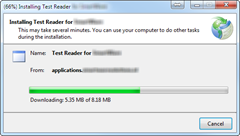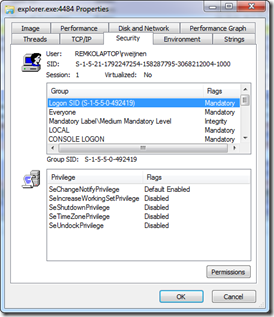Remko Weijnen's Blog (Remko's Blog)
About Virtualization, VDI, SBC, Application Compatibility and anything else I feel like
Archive for the ‘Windows 2008 R2’ Category
The publisher could not be verified when launching an application with RES Workspace Manager
Author: Remko Weijnen13 Sep
Today I was troubleshooting a warning message that popped up when launching a network application with RES Workspace Manager:
Usually this is a simple fix: add the servername (file://server) to the Local Intranet zone:
That worked when I launched the application directly. However when launching the application with RES Workspace Manager I would still get the warning. Even stranger: when I clicked Cancel the application would still be launched.
ClickOnce Applications in Enterprise Environments
Author: Remko Weijnen5 Aug
ClickOnce is a Microsoft technology that enables an end user to install an application from the web without administrative permissions.
That’s great isn’t it?
While ClickOnce may sound great to developers it’s actually a nightmare for Enterprise administrators because they try to prevent users from installing software themselves.
ClickOnce also incorporates an Automatic Updates mechanism which means that users might run different or not tested/approved versions…
Virtual Environments
It get’s even worse in virtual environments such as VDI and SBC where machines are often non-persistent. Each time the users starts the application they will see a screen similar to the one below while they actually download and install it over and over again:
If the environment is persistent, it’s not guaranteed that the user works on the same machine each day. This means that the application will be installed on every box the user ever logs onto…
How does it work?
In order to understand how we can best treat ClickOnce applications we need to understand how they work since MSDN documentation does not describe this in detail.
Return username instead of computername to Applications
Author: Remko Weijnen6 Dec
 Some applications use the computer’s name as a unique identifier, rather than using the user name. In a single-user-per-computer environment, this strategy works well.
Some applications use the computer’s name as a unique identifier, rather than using the user name. In a single-user-per-computer environment, this strategy works well.
However, in a Multi User environment such as Citrix XenApp or Microsoft’s Remote Desktop Services (Terminal Server), all connected users report the same computername.
If the application relies on unique computernames to handle tasks such as file and record locking, then the application will fail.
![]() We can however set an Application Compatibility Flag in the registry to return the username instead of the computername.
We can however set an Application Compatibility Flag in the registry to return the username instead of the computername.
To demonstrate this behaviour I wrote a small Test Application called TestAppCompatFlags.exe.
My Network Places Internals
Author: Remko Weijnen19 Jul
 I am using a PowerShell script to copy some elements of from the users old profile location to a new location. This includes the Nethood ("My Network Places") folder which contains the Network Places shortcuts.
I am using a PowerShell script to copy some elements of from the users old profile location to a new location. This includes the Nethood ("My Network Places") folder which contains the Network Places shortcuts.
A user reported that she could not save documents to Network Places anymore and after inspection the Network Places shortcuts were broken.
I started comparing the old Nethood folder to the new and observed the following difference in Explorer:
When copying entries from the Nethood folder with Explorer manually they worked fine, so somehow Explorer gives the Nethood folder special treatment.
Switching to the Services Session
Author: Remko Weijnen24 Feb
Just read a tweet from @andyjmorgan about Interactive Service Detection. This made me remember that it’s possible to switch to the Session 0 with an undocumented api in winsta.dll.
For this API to work you must have the Interactive Services Detection (UI0Detect) service running.
Remote Registry from 32 to 64 bit
Author: Remko Weijnen21 Oct
![]() Yesterday I needed to set a few registry keys remotely from a 32 bit windows machine to a 64 bit machine.
Yesterday I needed to set a few registry keys remotely from a 32 bit windows machine to a 64 bit machine.
I used reg.exe to set the key but even though it returned success the key wasn’t altered.
As I suspected the key was written to the Wow6432Node. In the help I couldn’t find any switch to force reg.exe to use the 64-bit view.
On a 64 bit machine this is not a problem since both 32- and 64 bit versions of reg.exe exists. The 32 bit version of reg.exe defaults to the 32 bit view and the 64 bit version defaults to the 64 bit view.
But luckily reg.exe has a switch (that is not listed in the help) to force the View:
Prevent additional IP addresses from being registered in DNS
Author: Remko Weijnen18 Oct
 In Windows 7 and 2008 R2 all IP Addresses are by default registered in DNS.
In Windows 7 and 2008 R2 all IP Addresses are by default registered in DNS.
If you don’t want certain IP addresses to appear in DNS you can alter this behavior with Netsh using the skipassource flag.
Use the following syntax to add an additional IP Address with skipassource flag:
GetUserObjectInformation fails with Access Denied
Author: Remko Weijnen16 Aug
![]() Today I was reusing some old (pre vista) code the retrieves the Logon SID that I wrote a few years ago. The Logon SID is a special SID that identifies a logon session that has the form S-1-5-5-X-Y.
Today I was reusing some old (pre vista) code the retrieves the Logon SID that I wrote a few years ago. The Logon SID is a special SID that identifies a logon session that has the form S-1-5-5-X-Y.
You can view your Logon SID with Process Explorer, right click a GUI process, select Properties and goto the Security Tab:
GetTokenInformation with TokenLinkedToken returns error 1312
Author: Remko Weijnen11 Aug
The GetTokenInformation function can be used with the TokenLinkedToken Information Class on Windows Vista and higher to the linked (Elevated) token.
This is useful when User Account Control is enabled and you want to launch an elevated process e.g. from a service.
This example code fails however when User Account Control is disabled:
1 2 3 4 5 6 7 8 9 | if (bElevate) { ZeroMemory(&tlt, sizeof(tlt)); bResult = GetTokenInformation(hToken, TokenLinkedToken, &tlt, sizeof(tlt), &RetLength); if (!bResult) { // Handle error here } } |
GetLastError() returns 1312 which is defined in winerror.h as ERROR_NO_SUCH_LOGON_SESSION with description “A specified logon session does not exist. It may already have been terminated.”
So you should check if User Account Control is enabled in such cases (or make this error non critical).
Programmatically Check if User Account Control is Enabled
Author: Remko Weijnen11 Aug
Snippet below can be used to programmatically determine if User Account Control is enabled:
1 2 3 4 5 6 7 8 9 10 11 12 13 14 15 | uses JwaWinbase, JwaWinNt; function IsUACEnabled: Boolean; var hToken: THandle; tet: TOKEN_ELEVATION_TYPE; dwSize: DWORD; begin Win32Check(OpenProcessToken(GetCurrentProcess, TOKEN_QUERY, hToken)); // TokenElevationType class only available on Vista+ Win32Check(GetTokenInformation(hToken, TokenElevationType, @tet, SizeOf(tet), dwSize)); Result := tet <> TokenElevationTypeDefault; end; |
Profile
Top Posts
- Query Active Directory from Excel
- RNS 510 Startup Logo–My thoughts
- Adding a hidden Exchange mailbox to Outlook
- How rdp passwords are encrypted
- Get Actual CPU Clock Speed with PowerShell
- ClickOnce Applications in Enterprise Environments
- VW RNS 510 Navigation Startup Pictures
- Unattended Installation of IBM System i Access for Windows
- Reading physical memory size from the registry
- Show Client IP Address when using NetScaler as a Reverse Proxy
Recent Comments
Featured Downloads
- AClientFix (13595 downloads )
- AddPrinter2.zip (12854 downloads )
- AdProps (12379 downloads )
- AdSample1 (11432 downloads )
- AMD Radeon Crimson ReLive (30107 downloads )
- Atheros Driver (34019 downloads )
- AutoLogonXP 1.0 (11404 downloads )
- CDZA (9560 downloads )
- ChDrvLetter.zip (11217 downloads )
- ChDrvLetter.zip (14356 downloads )
Blogroll
- Andrew Morgan
- Arnout’s blog
- Assa’s Blog
- Barry Schiffer
- Delphi Praxis
- Ingmar Verheij
- Jedi Api Blog
- Jedi API Library
- Jeroen Tielen
- Kees Baggerman
Categories
- .NET (4)
- Active Directory (28)
- Altiris (36)
- App-V (1)
- Apple (5)
- Application Compatibility (11)
- Automotive (5)
- AWS (1)
- BootCamp (1)
- C# (6)
- C++ (2)
- Citrix (87)
- Delphi (61)
- Embedded (4)
- Exchange (16)
- General (71)
- iPhone (5)
- Java (8)
- Linux (1)
- Lync (2)
- NetScaler (1)
- Oracle (4)
- Other (1)
- Packaging (19)
- PowerShell (56)
- Programming (79)
- Quest (1)
- RES (7)
- script (22)
- ShareFile (1)
- SQL Server (10)
- Strange Error (3)
- Terminal Server (68)
- ThinApp (3)
- ThinKiosk (1)
- Ubuntu (1)
- Unattended Installation (19)
- Uncategorized (51)
- UWP (2)
- Vista (37)
- Visual Studio (1)
- VMWare (26)
- Windows 10 (2)
- Windows 2003 (30)
- Windows 2008 (37)
- Windows 2008 R2 (16)
- Windows 2012 (2)
- Windows 7 (30)
- Windows 8 (4)
- Windows Internals (12)
- Windows XP (16)
Archives
- February 2023 (1)
- October 2022 (3)
- July 2022 (1)
- June 2022 (2)
- October 2019 (1)
- March 2018 (1)
- January 2018 (4)
- December 2017 (3)
- April 2017 (1)
- March 2017 (5)
- February 2017 (4)
- May 2016 (3)
- March 2016 (1)
- October 2015 (2)
- September 2015 (1)
- January 2015 (1)
- August 2014 (1)
- July 2014 (8)
- May 2014 (1)
- November 2013 (1)
- October 2013 (2)
- September 2013 (3)
- August 2013 (4)
- June 2013 (2)
- May 2013 (3)
- April 2013 (5)
- March 2013 (5)
- February 2013 (1)
- January 2013 (5)
- December 2012 (9)
- November 2012 (3)
- October 2012 (3)
- August 2012 (4)
- July 2012 (2)
- June 2012 (1)
- May 2012 (6)
- March 2012 (13)
- February 2012 (12)
- January 2012 (9)
- December 2011 (9)
- November 2011 (4)
- October 2011 (5)
- September 2011 (10)
- August 2011 (10)
- July 2011 (2)
- June 2011 (8)
- May 2011 (12)
- April 2011 (4)
- March 2011 (14)
- February 2011 (8)
- January 2011 (32)
- December 2010 (23)
- November 2010 (19)
- October 2010 (10)
- September 2010 (6)
- August 2010 (1)
- July 2010 (1)
- June 2010 (6)
- March 2010 (7)
- February 2010 (3)
- December 2009 (3)
- November 2009 (11)
- September 2009 (2)
- July 2009 (1)
- June 2009 (5)
- May 2009 (1)
- April 2009 (2)
- March 2009 (3)
- February 2009 (6)
- January 2009 (3)
- December 2008 (8)
- November 2008 (5)
- October 2008 (3)
- September 2008 (3)
- August 2008 (3)
- June 2008 (6)
- May 2008 (2)
- April 2008 (3)
- March 2008 (5)
- January 2008 (3)
- December 2007 (3)
- November 2007 (13)
- October 2007 (10)





